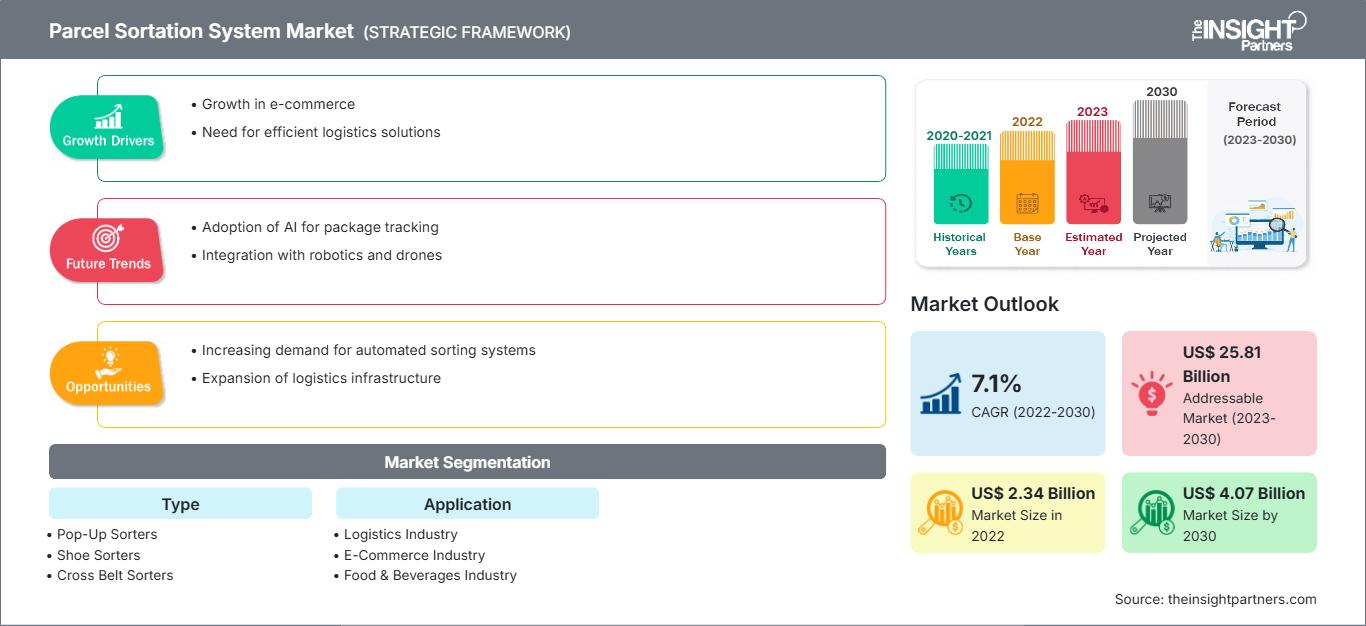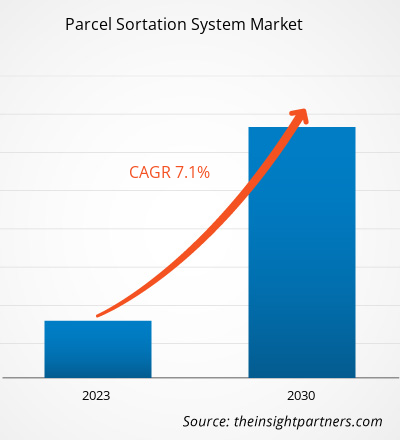[研究报告]包裹分拣系统市场规模预计将从2022年的23.4亿美元增长到2030年的40.7亿美元;预计2022年至2030年的复合年增长率将达到7.1%。
分析师观点:
随着技术的发展,包裹分拣系统行业在过去几年中发生了巨大变化。自动化技术对多个终端行业产生了积极影响,发达地区和发展中地区对各种自动化技术的采用都在持续增长。制造业是最早采用自动化技术的行业之一,这主要归因于劳动力成本的上升和人口老龄化。为了满足不断增长的客户需求,制造业的生产活动迅速增加,终端行业对包裹分拣系统的需求也在持续增长,这推动了包裹分拣系统市场规模的扩大。
包裹分拣系统市场概况:
消费品产量的增加和电子商务领域的显著发展,推动了包裹分拣系统市场的增长。然而,包裹分拣系统的技术复杂性制约了市场的增长。此外,仓库管理系统需求的不断增长以及包裹分拣系统成本的总体下降,预计将在未来几年为包裹分拣系统市场参与者提供充足的机会。
随着包裹分拣系统需求的持续增长,许多包裹分拣系统市场的参与者正在投资新仓库,以保持竞争力。这些公司正在开发新产品,以在全球包裹分拣系统市场中保持领先地位。例如,亚马逊宣布投资1亿美元在墨西哥开设新的自动分拣系统仓库,其中包括其在人口稠密的首都地区以外的首个配送中心,以提供更快的配送速度。新站点包括两个配送中心——分别位于北部城市蒙特雷和中部城市瓜达拉哈拉附近。该平台为产品从分拣系统中取出提供了多种选择——水平、下降、动力和重力等多种分拣方式,可提供紧凑且可控的分拣。此外,英特诺还开发了一种新型进料模块,扩展了其模块化平台解决方案,并实现了高效的物料流。新型进料模块旨在与英特诺交叉带式分拣机配合使用。
自定义此报告以满足您的要求
您将免费获得任何报告的定制,包括本报告的部分内容,或国家级分析、Excel 数据包,以及为初创企业和大学提供超值优惠和折扣
包裹分拣系统市场: 战略洞察

-
获取本报告的主要市场趋势。这个免费样本将包括数据分析,从市场趋势到估计和预测。
包裹分拣系统市场的驱动因素:
消费品产量不断增长,自动化技术的应用日益普及
全球人口的增长极大地增加了汽车、制药、零售、电子、食品饮料以及许多其他行业对多种产品类别的需求。为了满足这种不断增长的需求,制造商正在做出各种努力来大幅提高产量,这也对分拣和仓储设施产生了广泛的需求。仓库、仓储中心和配送中心在维护各公司的消费品库存方面发挥着至关重要的作用。存储过程中对产品的损坏最小、存储成本低以及易于分拣是高效仓储和分拣系统的一些重要特性,这些特性促使制造商和供应链合作伙伴对其需求不断增长。
此外,各种自动化技术的采用在全球范围内持续增长。由于劳动力成本的上升以及人口老龄化,制造业是自动化技术的主要采用者。自动化技术也促进了制造业的产量增长和收入增长。随着消费品数量的增长,包裹分拣中心面临着传统包裹分拣系统效率低下的挑战,例如分拣大量包裹、处理时间缩短以及技术错误增多。因此,为了克服这一挑战,并轻松地将包裹按指定区域分拣,仓库、物流设施中心、机场和造船厂正在越来越多地采购自动化技术。这一因素推动了包裹分拣系统市场规模的扩大。
包裹分拣系统市场细分分析:
根据类型,包裹分拣系统市场细分为:
- 弹出式分拣机
- 鞋式分拣机
- 交叉带式分拣机
- 倾斜托盘式分拣机
- 推盘式分拣机
- 其他
2022 年,交叉带式分拣机占据了包裹分拣系统最大的市场份额。交叉带式分拣机是目前速度最快的分拣机之一,每小时可分拣高达 25,000 个单元。这使其成为任何需要高速分拣和高吞吐量流程的绝佳解决方案。交叉带式分拣机有可能使涉及处理大量包含小立方体商品的小额订单的电子商务运营受益。这些系统用于订单履行、装运、交叉配送、配套、商店退货和补货、混合邮件分拣以及入站分拣以存放货物等应用。
包裹分拣系统市场的区域分析:
全球包裹分拣系统市场大致分为五大区域——北美、欧洲、亚太地区、中东和非洲地区 (MEA) 和南美地区 (SAM)。凭借强大的制造业基础、高昂的劳动力成本以及政府推动自动化的举措,欧洲已成为包裹分拣系统市场的主导领域。其他各种因素,例如在主要城市和枢纽之间合理分布分拣中心,促进了跨境包裹流动和先进系统的采用,包括西欧汽车工业中的机器人技术。
预计亚太地区将在预测期内创下包裹分拣系统市场扩张最快的纪录。人口的大幅增长和可支配收入的提高是该地区包裹数量增加的一些因素;因此,为了管理如此增长的包裹量,物流企业正在使用包裹分拣系统等先进技术。此外,快速发展的电子商务市场也催生了该地区对高效包裹分拣系统的需求。此外,中国和印度人口稠密的城市中分拣中心数量的增加也推动了亚太地区包裹分拣系统市场份额的增长。
主要参与者分析:
Bastian Solutions, LLC;大福株式会社;德马泰克;霍尼韦尔国际公司;村田机械有限公司;英特诺集团;伯曼集团;Viastore Systems;范德兰德工业公司和西门子物流有限公司是报告中提到的包裹分拣系统市场的主要参与者。在这些参与者中,库卡股份公司、发那科公司、ABB 有限公司、川崎重工业有限公司和安川美国公司凭借其多样化的产品组合,位列包裹分拣系统市场前五名。
包裹分拣系统市场区域洞察
The Insight Partners 的分析师已详尽阐述了预测期内影响包裹分拣系统市场的区域趋势和因素。本节还讨论了北美、欧洲、亚太地区、中东和非洲以及南美和中美洲的包裹分拣系统市场细分和地域分布。
包裹分拣系统市场报告范围
| 报告属性 | 细节 |
|---|---|
| 市场规模 2022 | US$ 2.34 Billion |
| 市场规模 2030 | US$ 4.07 Billion |
| 全球复合年增长率 (2022 - 2030) | 7.1% |
| 历史数据 | 2020-2021 |
| 预测期 | 2023-2030 |
| 涵盖的领域 |
By 类型
|
| 覆盖地区和国家 |
北美
|
| 市场领导者和主要公司简介 |
|
包裹分拣系统市场参与者密度:了解其对业务动态的影响
包裹分拣系统市场正在快速增长,这得益于终端用户需求的不断增长,而这些需求的驱动因素包括消费者偏好的不断变化、技术进步以及对产品优势的认知度不断提高。随着需求的增长,企业正在扩展其产品线,不断创新以满足消费者需求,并抓住新兴趋势,从而进一步推动市场增长。

- 获取 包裹分拣系统市场 主要参与者概述
包裹分拣系统市场中的公司正在大力采用收购和兼并等非有机和有机战略。以下列出了包裹分拣系统市场的一些关键最新发展:
- 2023年3月,西门子物流获得一份合同,将在中国合肥新桥机场新建的2号航站楼(T2)部署其行李处理和分拣技术。根据合同,西门子物流将提供其VarioTray个人行李箱系统,以确保无缝行李处理。
- 2022年11月,自动化物料处理系统供应商伯曼集团宣布计划对Helthjem的新包裹终端(挪威快递包裹递送业务)进行自动化改造。伯曼系统将主要处理大部分进入系统的包裹,直到它们被分拣出来,以进一步优化配送。该系统将最大限度地减少年度处理量,减少每个包裹的接触点数量,从而极大地影响吞吐量的速度和准确性。
- 2021年,全球自动化物料处理系统供应商伯曼集团向拉格比的赫尔墨斯米德兰兹超级枢纽提供了第三套分拣系统,该系统每天可分拣超过一百万件包裹。
- 2019年,伯曼集团与阿鲁巴机场管理局签署了一项价值3300万美元的协议。通过该协议,该公司将为阿鲁巴女王贝娅特丽克丝国际机场提供高速行李运输和分拣系统的设计和安装。
- 历史分析(2 年)、基准年、预测(7 年)及复合年增长率
- PEST和SWOT分析
- 市场规模、价值/数量 - 全球、区域、国家
- 行业和竞争格局
- Excel 数据集
近期报告
客户评价
购买理由
- 明智的决策
- 了解市场动态
- 竞争分析
- 客户洞察
- 市场预测
- 风险规避
- 战略规划
- 投资论证
- 识别新兴市场
- 优化营销策略
- 提升运营效率
- 顺应监管趋势






















 获取免费样品 - 包裹分拣系统市场
获取免费样品 - 包裹分拣系统市场